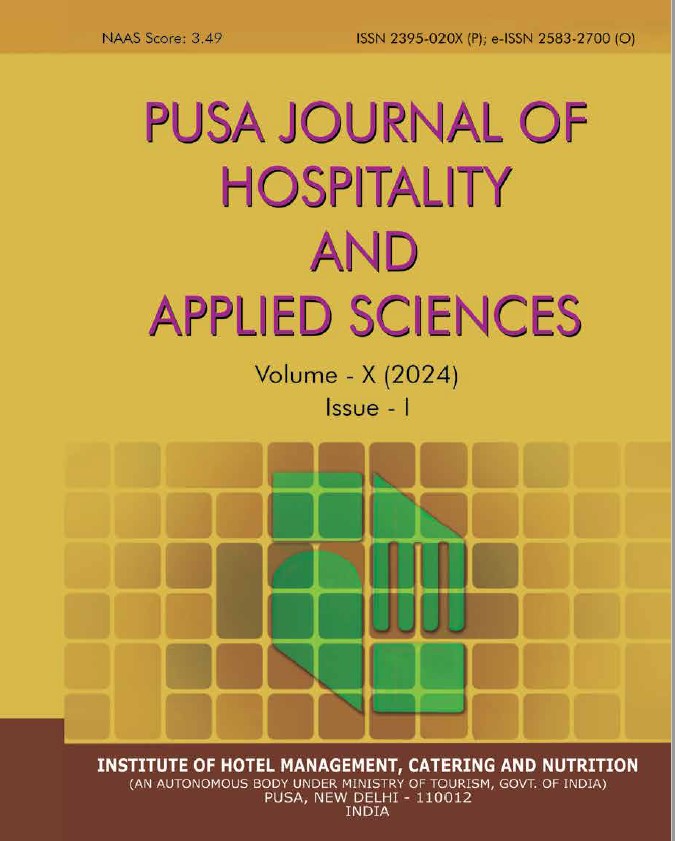A STUDY OF ERGONOMICS AND ITS EFFECT ON THE HOUSEKEEPING EMPLOYEES
DOI:
https://doi.org/10.48165/pjhas.2024.10.1.5Keywords:
Ergonomics, Musculoskeletal Disorder (MSD), Hotel Industry, Health and SafetyAbstract
Background: Ergonomics is the science of designing work as per the human body, it is used by the management to make the work processes safe for their workers. Housekeeping involves lots of physical work, therefore it is necessary that such research should be done on housekeeping department employees. Objectives: The objectives of this study were: to understand the application of ergonomics in the housekeeping department, to study the effects and challenges of ergonomics on the members of the housekeeping team, and to explore the awareness of ergonomics amongst the housekeeping employees. Methodology: The research design was a combination of experimental & descriptive. 100 housekeepers from 4 & 5 star hotels in Delhi-NCR were participants of the work. A questionnaire consisting of close ended and few open-ended questions was circulated among the respondents on one to one basis. To study the fatigue rate while working, oxygen and pulse rate of the respondents was also recorded. Data analysis was done on the basis of gender. Results: The findings state that 98% of the housekeeping department employees were aware about the concept of ergonomics and its application in housekeeping. Unfortunately, due to constraint of time and tight work schedule, a housekeeper cannot always follow the practices of ergonomic. Oxygen level decreased (98.15±0.08) after doing the task and the pulse rate increased (95.54±1.52) after completing their task. Conclusion: Housekeepers are exposed to a range of ergonomic risk factors and are prone to posture related injuries. It has also been seen that there is a substantial difference in level of energy lost when the housekeepers are working in a hurry.
References
Aina R., Raji A., & Abidin, E. Z. (2020). Distribution of musculoskeletal symptoms and ergonomic risk assessment among housekeepers at budget hotels in Sepang, Selangor. Malaysian Journal of Medicine and Health Sciences.101-108.
Anderson, J., Williams, A. E., & Nester C. (2017). An explorative qualitative study to determine the footwear needs of workers in standing environments. Journal of Foot & Ankle Research, 10. 10.1186/s13047-017-0223-4
Ashizawa, K. (2000). An overview of anthropometric studies in Japan. Proceedings of the Human Factors and Ergonomics Society Annual Meeting, 44(38), 755-757. https://doi.org/10.1177/154193120004403819
Chebet, M. S. (2021). Influence of ergonomics practices on the morbidity of housekeepers in three star hotels in Nairobi, http://hdl.handle.net/11071/12283
Chijioke, A. & Alozie, E. (2019) ‘Effect of ergonomics risk factors on housekeepers in hotel operations’- International Journal of Scientific Research in Humanities, Legal Studies & International Relations, 4(1).1-20.
Frumin, E., Moriarty, J., Vossenas, P., Halpin, J., Orris, P. & Krause, N. (2006). Workload-related musculoskeletal disorders among hotel housekeepers: Employer, ResearchGate.
Joshi, S. (2016). Study of relationship between ergonomics & efficiency of the housekeeping employees at workplace. Atithya: A Journal of Hospitality; 2(1). 10.21863/ ATITHYA/2016.2.1.024
Luz, E. M., Oclaris, L. M., Morais, B. X., Silva, S.C., Almeida, F. O., & Magnago, T. S.B. (2021). Strategies to minimize ergonomic risks in the cleaning staff, Cogitare enferm. 26 (e71073). 10.5380/ce.v26i0.71073
Mansour, N. M. & Abdelaal, F. M. (2021) The relationship between ergonomics and health problems: A study on hotel room attendants in three-star hotels. JFTH,18(1), 246-256.
Parmar, S., & Dalal, P. (2017) ‘A study of musculoskeletal disorder among housekeeping staff in hotel industry.
Rahman, M. N. A., and Jaffar, M. S. M. (2017). Musculoskeletal symptoms and ergonomic hazards among room attendants in hotel industries. Human Factors and Ergonomics Journal, 2 (1), 24 – 33.
Rahman, M. N. A., Jaffar, M. S. M., Hassan, M. F., Ngali M. Z., & Pauline O. (2017). Exposure level of ergonomic risk factors in hotel industries. IOP Conference Series Materials Science and Engineering 226(1):012018. DOI.10.1088/1757-899X/226/1/012018
Sánchez-Rodríguez, C., Bulilete, O., Chela-Alvarez, X., Velasco-Roldán, O., & Llobera-Canaves, J. (2022). Chronic pain and work conditions of hotel housekeepers: A descriptive study. International Journal of Environment Research Public Health, 13;19(6), 3383. doi: 10.3390/ijerph19063383
Seifert, A. M., & Messing, K. (2006). Cleaning up after globalization: an ergonomic analysis of work activity of hotel cleaners, https://doi.org/10.1111/j.0066- 4812.2006.00595.x
Sianoja, M., Kinnunen, U., Bloom, J., Korpela, K., & Geurts, S. (2016). Recovery during lunch breaks: Testing long term relations with energy levels at work. Scandinavian Journal of Work and Organizational Psychology 1(1), 1-12 DOI:10.16993/sjwop.13
Siaw, G. A. (2018) ‘Influence of working conditions on the safety of housekeeping staff in budget hotels in eastern region of Ghana’ http://ir-library.ku.ac.ke/ handle/123456789/18612
Weigall, F., Simpson, K., Bell, A. F., & Kemp, L. (2005) ‘An assessment of the repetitive manual tasks of cleaners, WorkCover NSW, Sydney. Assessmentoftherepetitivemanualtasksofcleaners.pdf
Yung, M. (2016). Fatigue at the workplace: Measurement and temporal development. https://uwspace.uwaterloo. ca/bitstream/handle/10012/10119/Yung_Marcus. pdf;sequence=1




